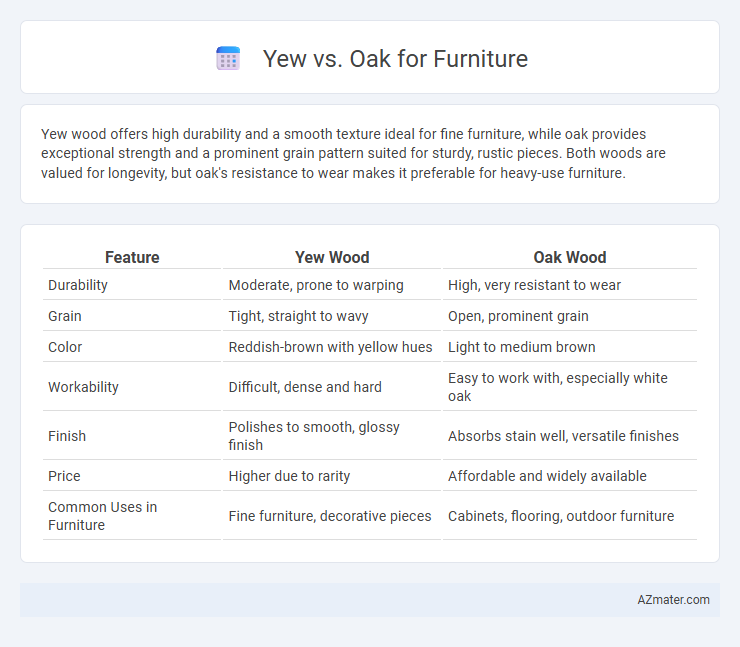Yew wood offers high durability and a smooth texture ideal for fine furniture, while oak provides exceptional strength and a prominent grain pattern suited for sturdy, rustic pieces. Both woods are valued for longevity, but oak's resistance to wear makes it preferable for heavy-use furniture.
Table of Comparison
| Feature | Yew Wood | Oak Wood |
|---|---|---|
| Durability | Moderate, prone to warping | High, very resistant to wear |
| Grain | Tight, straight to wavy | Open, prominent grain |
| Color | Reddish-brown with yellow hues | Light to medium brown |
| Workability | Difficult, dense and hard | Easy to work with, especially white oak |
| Finish | Polishes to smooth, glossy finish | Absorbs stain well, versatile finishes |
| Price | Higher due to rarity | Affordable and widely available |
| Common Uses in Furniture | Fine furniture, decorative pieces | Cabinets, flooring, outdoor furniture |
Yew vs Oak: Introduction to Furniture Woods
Yew and oak are two distinct hardwoods commonly used in furniture making, each offering unique characteristics suited to different styles and purposes. Yew wood is prized for its fine grain, rich reddish-brown color, and flexibility, making it ideal for intricate carvings and elegant pieces. Oak, known for its durability, prominent grain pattern, and strength, is favored for robust, long-lasting furniture that withstands heavy use.
Botanical Characteristics: Yew and Oak
Yew (Taxus baccata) features dense, fine-grained wood with a rich reddish-brown color and natural resistance to decay, making it ideal for intricate furniture designs. Oak (Quercus species), known for its prominent grain and durability, offers a harder, heavier wood with a light to medium brown hue often used in robust furniture construction. The botanical distinction includes Yew's evergreen needle-like foliage and red arils contrasted with Oak's broad, lobed leaves and acorn fruit, influencing wood texture and aesthetics in furniture applications.
Durability and Longevity Comparison
Yew wood offers moderate durability with a fine grain and natural resistance to decay, making it suitable for indoor furniture but less ideal for heavy-use pieces. Oak, particularly white oak, is renowned for its exceptional hardness, strength, and natural resistance to moisture and insect damage, ensuring superior longevity and durability in both indoor and outdoor furniture. The dense, tightly-grained structure of oak contributes to its ability to withstand wear and maintain structural integrity over decades, surpassing yew in long-term furniture applications.
Grain Patterns and Aesthetic Appeal
Yew wood features a fine, straight grain with occasional interlocking patterns that create a smooth, elegant surface prized in bespoke furniture making. Oak displays a prominent, coarse grain with distinctive rays and flecks, offering a robust and classic aesthetic favored for both traditional and rustic furniture styles. The natural hues of yew range from creamy yellow to rich reddish-brown, while oak varies from light tan to deep amber, impacting the visual warmth and character of the finished piece.
Workability: Crafting Yew vs Oak Furniture
Yew wood offers exceptional workability for furniture crafting due to its fine grain and elasticity, allowing intricate carving and smooth finishes. Oak, characterized by its coarse grain and hardness, demands more effort during shaping but delivers outstanding durability and a robust structure. Craftsmen often select yew for detailed ornamental pieces, while oak is favored for sturdy, long-lasting furniture designs.
Resistance to Decay and Insect Damage
Yew wood exhibits moderate resistance to decay and insect damage due to its dense grain and natural oils, making it suitable for indoor furniture. Oak, particularly white oak, offers superior resistance to decay and insect infestation because of its tight grain structure and high tannin content, which naturally deters pests and moisture. For furniture longevity, oak is often preferred in environments prone to humidity and insect exposure, while yew is chosen for its aesthetic appeal and moderate durability.
Color and Finish Possibilities
Yew wood offers a rich, warm golden to reddish-brown color with a natural sheen that enhances intricate grain patterns, making it ideal for polished or satin finishes that highlight its smooth texture. Oak, known for its light to medium brown tones with prominent grain and occasional knots, provides versatile finishing options, including matte, waxed, or stained finishes that emphasize its robust, rustic character. Both woods respond well to stains and oils, but Yew's finer grain allows for a more refined, elegant look, while Oak's coarser grain supports a more traditional, durable appearance.
Sustainability and Sourcing Issues
Yew wood, prized for its dense grain and natural resistance to decay, offers a sustainable option due to its slow growth and ability to regenerate in managed forests, contrasting with oak, which is more widely available but often sourced from intensive logging practices impacting biodiversity. Oak's faster growth rate supports larger-scale production, yet unsustainable harvesting and deforestation linked to some oak supplies raise environmental concerns. Sourcing certified timber from FSC or PEFC programs ensures both yew and oak furniture minimizes ecological impact, promoting responsible forestry and long-term resource availability.
Common Uses in Furniture Design
Yew wood is prized in furniture design for its fine grain, elasticity, and rich reddish-brown color, making it ideal for crafting intricate carvings, bow-shaped furniture, and decorative veneer work. Oak, both red and white varieties, offers exceptional strength, durability, and a prominent grain pattern, commonly used for heavy-duty pieces like tables, chairs, cabinets, and flooring. The contrasting hardness and workability between yew and oak influence their application in furniture, with yew favored for ornamental and lightweight designs and oak selected for robust, long-lasting furniture structures.
Price, Value, and Availability
Yew wood tends to be more expensive than oak due to its rarity and slower growth, making it less available on the market. Oak offers excellent value with its durability and widespread availability, making it a popular, cost-effective choice for furniture. While yew furniture provides a unique, luxurious aesthetic, oak furniture balances affordability and long-lasting quality efficiently.

Infographic: Yew vs Oak for Furniture
 azmater.com
azmater.com